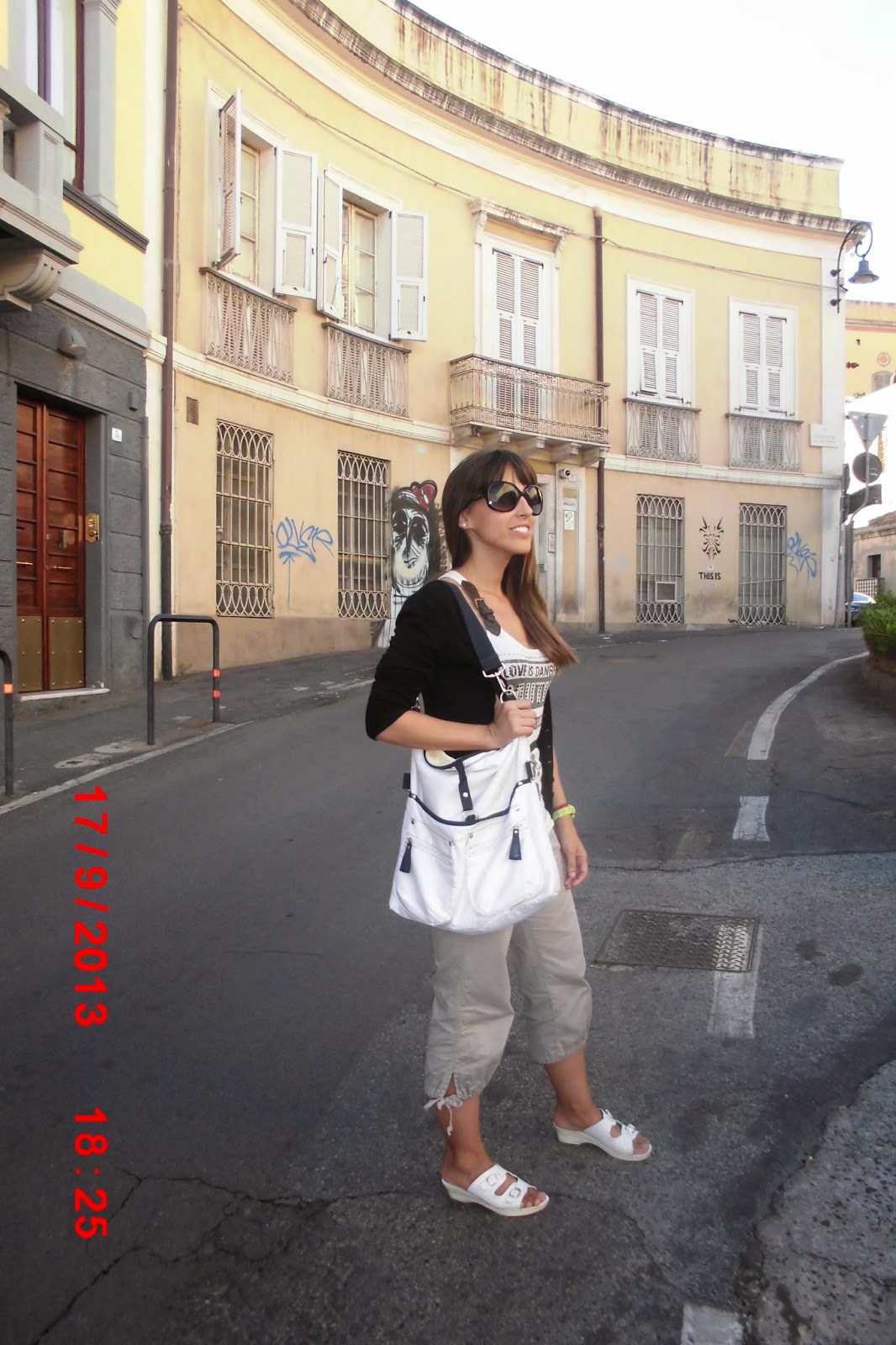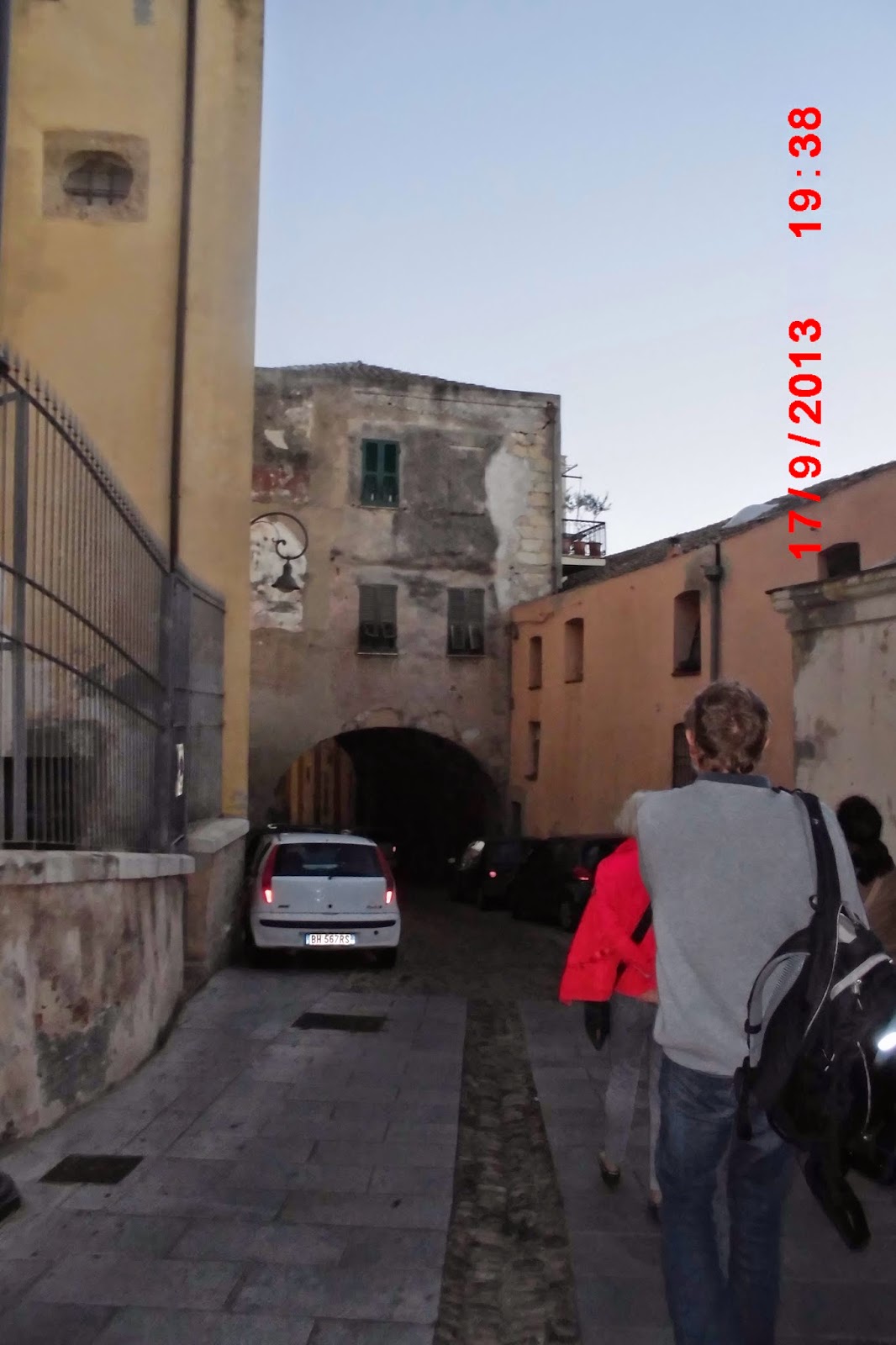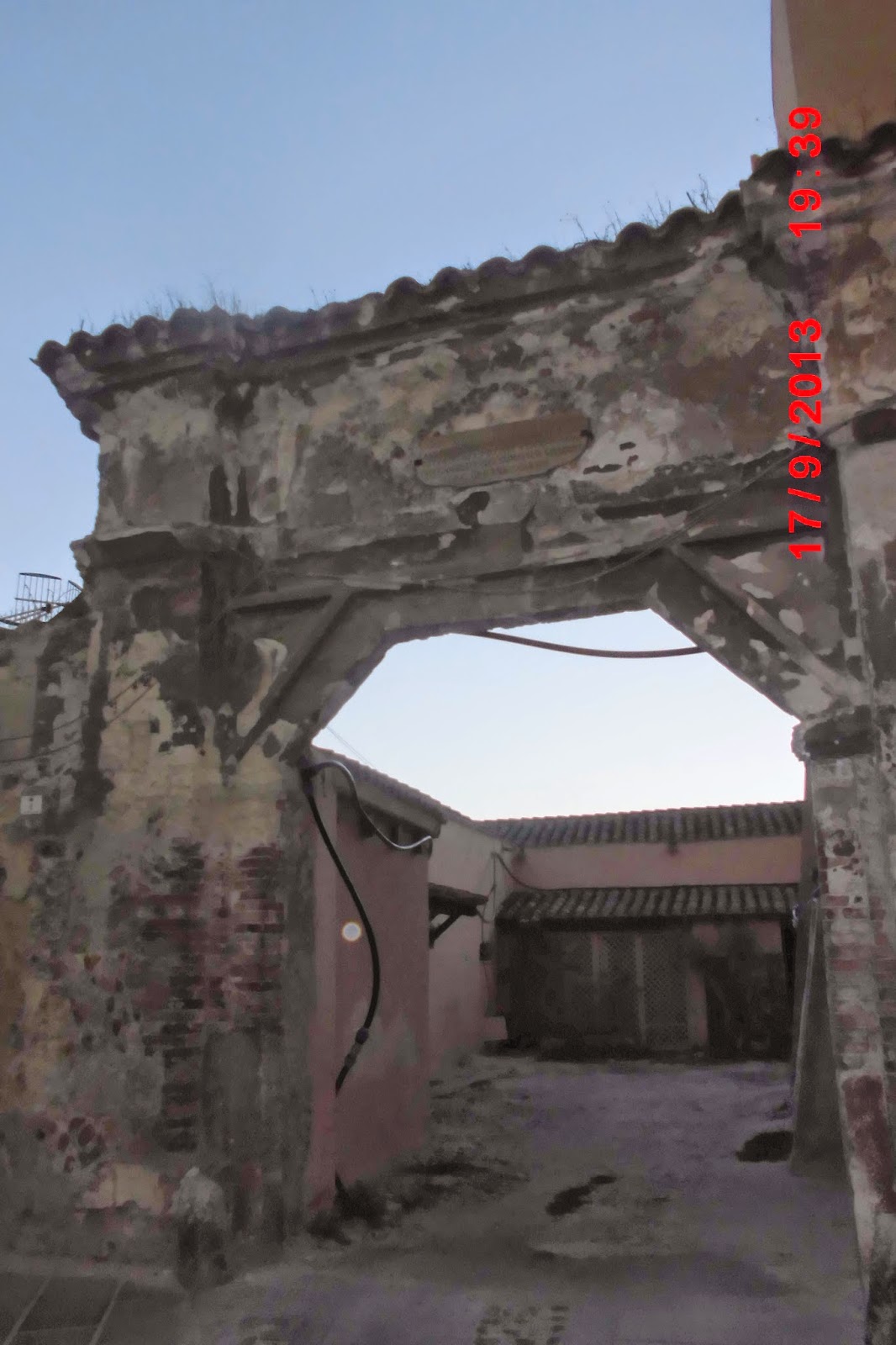16th September (Monday)
Monday sunny morning. First pictures from the flat I lived
Monday sunny morning. First pictures from the flat I lived
First day of the course.
I arrived and I met Simona and Anna Rita (Italian teachers at school). I was at the level of high intermediate (upper-intermediate) with the the teacher Giuseppe. I introduced myself and I met other students of different levels: two retired German (a marriage) and a French man called Eric who was 45 years old but looked much younger. But all of them are in other classrooms. At my level was only a Swiss boy who was studying there from since 1 July! But that Monday he didn't go to class... so I was alone!!! Private lessons in One World Language Centre. We started at 9. After the presentations we spoke about Spain, politics and other issues... and then we started with grammar: passato remoto and trapassato.
Giuseppe gave me the book and also made photocopies of another grammar book that I already have. Usually at 11 a rest is made and the students and teachers go together to have lunch
The lunch was always at a coffee located in Via Farina, owned by Peruvians, called LA AVENTURA DEL CAFÈ. Friendly people and good prices. For only 90 cents you can eat a croissant or a cake... A watter bottle 1€. We have lunch outside, in the terrace. After half an hour, we went back to class. The first day of the course finished at 12:15. Veronica gave me the sheet with the activities of the week (Tuesday to Sunday)
I went home and I used the Skype to talk with my mother. I ate white chocolate (from Conad) with bread and a bag of cheese balls that I had bought, among other things... xD
This was the best bread I've ever tasted! Really soft!
BUONISSIMOOOOOOOOOOOO. 100% PRODOTTO ITALIANO
Cheese balls! Deliciousssssssssssss
Big beach bag
Picture below: Via San Giacomo from the balcony
In the afternoon I went for a walk around the old town centre. I took the direction to Piazza Garibaldi. In many streets by which I passed, I saw Chinese shops, some of them very large, with cute and cheap clothes. Much better than these type of stores in Spain by far. First, I bought a shirt for 11 euros, And in other shop I bought a summer shirt with the flag of Sardegna, plus several mugs, keychains, magnets, ... and other souvenirs at a great price :D
Sardinian souvenirs
Again on the way to Quartu for dinner with Simona, Joseph and Gabriele
Before to arrive at home we stopped at Il Poetto beach (the area of Quartu) to see the sea... But it was so cold!!! It felt like winter... OMG
La Marinella Beach Club (bar, pub and nightclub)
Poetto Quartu S.E.
Simona's minicar
In Quartu the streets were decorared because of the town's fiestas
Dinner! Pasta, pasta!!! And the second dish: chicken with French fries with ketchup!
The greatest moment of the night in which the protagonist was Gabriele xD
Funny moments
And finally, the highlight: Calle Crabittu!Sardinian cheese. HORRIBLE TASTE, very strong!!!
17th September (Tuesday)
In the Cafeteria La Aventura del Cafè having lunch during the break.
First picture: Giuseppe (left) and my classmate, Luca, from Switzerland
In the Cafeteria La Aventura del Cafè having lunch during the break.
First picture: Giuseppe (left) and my classmate, Luca, from Switzerland
Here I'm with Eric, Simona and Anna Rita
In the afternoon: visit organized by the school. It was a guided tour by Anna Rita. She showed us the beauty of this city, the most important sites of Cagliari!
The visit started late, at 18 (half an hour late), but we saw a lot of things. Anna R. explained us some historical facts and we learnt new things about the city. It was very interesting as we visited several churches, cathedrals, palaces, theaters, etc.: Bastione di Saint Remy, il Teatro Civico di Castello, la Torre di San Pancrazio, Torre dell'Elefante, il Palazzo Regio, S'Avanzada (or porta di San Pancrazio), il Monumento a San Francesco d'Assisi, l'Antico Palazzo di Città, la Cattedrale e Cripta dei Ss. Martiri, la Basilica e Santuario di N.S. di Bonaria, la Chiesa e Cripta di Sant'Efisio, and other places of great historical value!
Cagliari is the biggest city in Sardinia with about one hundred and sixty thousand inhabitants (157.000) and is the main political, administrative, economic and cultural centre of Sardinia and the main port of the island.
It's an emblem of evolution, change, freshness and life surrounded by water. It's situated in south Sardinia, in the middle of the Angels Gulf and between the Molentargius and Santa Gilla lagoons.
Cagliari has 4 historical districts: Stampace, the artistic district; la marina, the commercial district; Villanova, the farmers district and Castello, the noble district, where in old times lived the people of power.
Photos of the visit
Castello is one of the four historic districts of Cagliari that dominates the city from a high. The first nucleus of the city was probably formed by the Phoenicians acropolis of Karali. This hilltop citadel is Cagliari’s most iconic image, its domes, towers and palazzi, once home to the city’s aristocracy, rising above the sturdy ramparts built by the Pisans and Aragonese
Bastione di Saint Remy
In Via Giuseppe Mazzini, Cagliari city centre
Walking
through the streets of Castello you can sense the history of the most
authentic Cagliari, between the present and the past; the ancient
palaces and hidden churches where the narrow streets have changed little
since medieval times. You should't miss the magnificent Cathedral, the
Royal Palace,the wonderful sights of the terraces of the Bastion Saint Remy and Santa Croce, which in the summer nights are also the nightlife centre, etc.
The Civic Theatre of Castle (Old Town Theatre), in Italian Teatro Civico di Castello, is located in Via Mario de
Candia in the district of Castello. The historic
building, was recently restored and used again
We enjoyed the panoramic terrace of the rampart of Saint Remy
Terrace St. Remy Rampart (Bastione Saint Remy)
Great panoramic views. Splendid terrace overseeing the town and its port
The main monumental staircase, long and animated, starts from Costituzione square with several flights which merge in a stairhead which leads to the covered Passeggiata. This one develops on the side along Viale regina Elena with huge and luminous rooms, painted with bright colours and closed through big arcades with shutters put only in 1985.
Under a big arch which dominates all the building there is a stair with two circular flights which lead to the Terrace Umberto I, from where it is possible to enjoy a beautiful view on the city and on the sea.
The huge square has two more flights which lead to the next bastion of Saint Caterina, where there is the homonymous junior school.
Under a big arch which dominates all the building there is a stair with two circular flights which lead to the Terrace Umberto I, from where it is possible to enjoy a beautiful view on the city and on the sea.
The huge square has two more flights which lead to the next bastion of Saint Caterina, where there is the homonymous junior school.
View of the Bastione Saint Remy with the triumphal arch above the monumental staircase that connect the old quarters Castello (the upper town) and Villanova
Via Mario de Candia. He was an Italian tenor, one of the most famous of the century XIX
Taking a stroll through the old part of the city
Su due mari e un pensiero vola lento questo veliero
Cagliari is above all a historical city with an interesting archaeology
Italian flag
Cagliari is a really lively cultural centre which proudly keeps its complex and fascinating history’s memory alive! The picturesque city streets make the perfect backdrop =D
Piazza Carlo Alberto
Modest in size, Piazza Carlo Alberto is located at the heart of the Castello district. The square has an important historical significance: in the Middle Ages, here were executed, by beheading, the nobles sentenced to death
Nothing reminds of Piazza Carlo Alberto’s dark times today. At the west side you will find the stairs that connect the area to the above via Cannelles, beyond which you can see the prospects of the Former Town Hall and the Cathedral. On the opposite side stands one of the most beautiful noble residences in the neighborhood, palazzo Asquer. At the center of the square you can admire a statue of St. Francis of Assisi. Historic square, surrounded by monumental buildings
Statue of San Francesco d'Assisi (Saint Francis of Assisi).
The statue stands in front of Cagliari's Cathedral
The statue stands in front of Cagliari's Cathedral
Below you can see the Cathedral behind the statue
The Cathedral of Santa Maria di Castello in Piazza Palazzo 4
Cattedrale di Santa Maria di Castello is a combination of Romanesque, Baroque, and Romanesque Revival architectural styles, and holds seven centuries of historical memories of the city of Cagliari. The church probably founded in 1217, but was elevated to the rank of Cathedral in 1258. It's one of the best known and most visited monuments of Cagliari. The most famous feature of the cathedral is the Santuario dei Martiri (Shrine of the Martyrs), which is also the only part of the underground area that can be visited. There are numerous artworks adorning the cathedral, some of great artistic value, making this a treasure trove for lovers of beauty and art
Piazza Palazzo is the most important square of Cagliari. It owes its prestige to the historical and artistic importance of the buildings that surround it. The square takes its name from the Royal Palace (Palazzo Reale), the most important castle in Cagliari.
Other landmarks of Piazza Palazzo include the Archbishop’s Palace and the facade of the Cathedral, with its XIIIth century tower. The south side of the square is closed by the former Town Hall. Here you can see several pics of these historical buildings
Ex Palazzo di Città, piazza Palazzo 6. The old palace of the city
seen from Piazza Carlo Alberto
seen from Piazza Carlo Alberto
This is Piazza Carlo Alberto viewed from the stairs
Piazza Palazzo or Palace Square.
The Royal Palace is the building on the right with red blings
The Ancient Town Hall (in the picture), in Piazza Palazzo, is a historic building of Cagliari, first seat of the town hall and later of other important institutions of Cagliari.
The building dates back to 1331 and due to the subsequent refurbishments of the 18th century, it is characterize by a style known as Piedmont Baroque and is now seat of one of the Public Museums of the city of Cagliari
The building dates back to 1331 and due to the subsequent refurbishments of the 18th century, it is characterize by a style known as Piedmont Baroque and is now seat of one of the Public Museums of the city of Cagliari
Cagliari ready for the meeting with the Pope Francis (22th September)
More pics of the Cathedral of Santa Maria di Castello
The poster announces the arrival of the Pope Francis
Inside the Cathedral
Banners to receive the Pope. Speranza = hope
More photos in Piazza Palazzo. In the middle we can see the Torre di San Pancrazio, in English St. Pancras Tower. The tower was built in 1305 on the highest peak of what is now known as Castello. The construction was commissioned to Sardinian architect Giovanni Capula and it was intended to play a pivotal role in the city's new defensive system, protecting the northern entrance of Castello
The tower is made of white limestone and is open on the side facing piazza Indipendenza. During the Aragonese and then Spanish domination, the fourth wall of the tower was completed, allowing it to be used as a fortified warehouse and lodgings for civil servants. Until the end of the 19th century, the tower was used as a jail. At the beginning of the 20th century, the tower underwent major restoration work and was brought back to its original 3-wall shape
One of the most important historical buildings to be visited is the Palazzo Reale or Palazzo Viceregio, situated in Piazza Palazzo, in the Castle district. The Royal Palace has its origins fourteenth century and became the seat of the viceroy from 1337, at the behest of Peter IV of Aragon. Over the centuries, the building underwent several modifications and extensions. Today, the Royal Palace (Palazzo Reale) houses the Prefecture of Cagliari. Few visitors know that the palace can be visited, and that this the interiors are, indeed, worthy of royalty. There’s a policeman guarding the door, but if you ask for permission to see the building inside, he will welcome you with a smile. Don’t miss it, after all, it’s free to go in, and to admire monumental frescoes by Domenico Bruschi! :-)
The funny thing when we got into the Palace was no one else in building: no other tourists, no security guards. It was like we had snuck in!!!
Cagliari province assembly room. The Council chamber
The funny thing when we got into the Palace was no one else in building: no other tourists, no security guards. It was like we had snuck in!!!
Cagliari province assembly room. The Council chamber
Luxury and refinement
Amazing ceilings, chandeliers, etc. Decoration in the main chamber
Main room's statue
Beautiful ceilings and walls were painted by Domenico Bruschi with an allegorical figures
Most important rooms, in addition to the Council chamber, are the hall of the halberdiers that houses an interesting collection of Savoy Vice kings portraits, the red room and the yellow hall. It is also important the large curved staircase on the main entrance.
The Red Hall is a small room furnished with velvet sitting-rooms, great golden mirrors and finest furniture of the period
Besides, another amazing room, the Green Hall, painted with vivid colours, welcomes in the interior the portrait of Vittorio Emanuele II
The entrance stairs
Administration offices and entrances are in the first and third floor, while the second level hosts all representative spaces (included the Council chamber), most architectural and artistic valuable. Currently the building is the seat of Prefecture and it hosts exhibition and representative areas of Province of Cagliari.
In the photo below you can see an informative poster about the Palace
Tourist Information
Gorgeous views
Unusual cloud!!!
The Santa Croce Rampart offers one of the most beautiful panoramic views from the uptown; it's situated in the district of Castello, a few steps from the Elephant Tower
The Santa Croce Rampart, commonly known as "Santu Juanni" Rampart, is situated in the street of the same name, once included in the Giudaria, the jewish neighbourhood. According to the sources, that neighbourhood developed in Castello starting from the 13th century, but it was in the 15th century, under the Aragonese domination, that it reached its maximum expansion
T-Hotel, the most modern building in the city.
In the photo below we can see the T-hotel and quartiere Fonsarda
In the photo below we can see the T-hotel and quartiere Fonsarda
Fonsarda is a district of Cagliari, a residential and commercial, built in the second half of the twentieth century. Today the neighborhood is characterized by palaces and, in one part, villas with gardens, making it mostly a quiet neighborhood :-)
Anna Rita & me
With Eric, my French friend
Eric, Anna Rita and the German marriage
Big cactus
Centro Comunale d'Arte e Cultura Il Ghetto Cagliari (The Guetto): The building known as the "Jewish Ghetto" is located on the bastion of Santa Croce, between the Santa Croce street and Cammino Nuovo, overlooking the walls of Castello district. It was founded in 1738 as a military barracks
The building designed by the Piedmontese military engineers, was built to house the department of "Dragons ", and had military functions until the nineteenth century. In 1863, the barracks, known as the San Carlo Barracks, contained more than 300 men and 40 horses, accommodation for veterans, Police stables, warehouses of military genius, etc. At the end of the 19th century, ended the military use, the building was sold to private and converted into small houses. The incorrect designation of "Jewish Ghetto"comes from the fact that there was actually, a little further, the neighborhood where Jewish lived, between Santa Croce and Via Stretta. The presence of the Jews in Cagliari in fact lasted until 1492, the year of promulgation of an edict by which the kings of Castile and Aragon (Sardinia was part of that kingdom) drove the Jews out from all their territories
A pretty female cat
The magical sunset in Cagliari
The old entrance to the barracks
Map of the city
At the end of the day we went to We went to Caffè Libarium Nostrum in Via Santa Croce 33/35 for an aperitif (or almost a dinner) and they served some snacks before (cheese and salami, etc.)
I don't like the tomatoe :P
Here I was next to Eric, the French student. The photo was taken by a Sardinian friend of Eric, who came later ... Very nice people in a very nice place :-) There were also Anna Rita and the German couple
.jpg)
.JPG)
.JPG)
.JPG)






































.jpg)


.JPG)
































































































.JPG)
.JPG)

.jpg)

.jpg)























.JPG)

.JPG)




.JPG)

.JPG)

.JPG)

.JPG)

.JPG)
.JPG)
.JPG)














































.jpg)

No comments:
Post a Comment